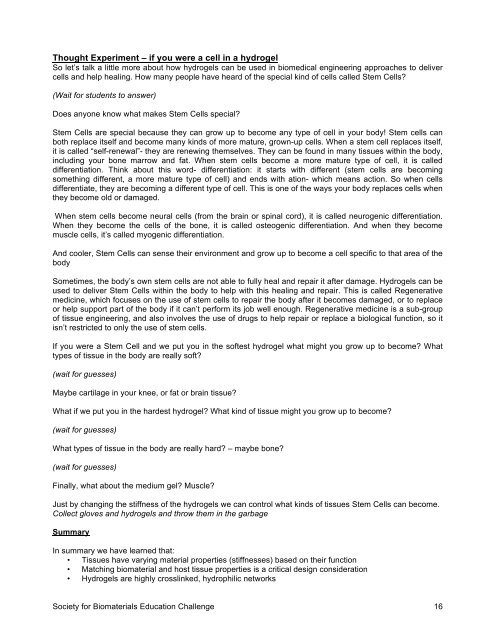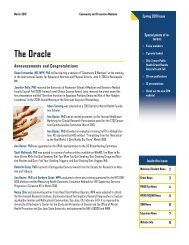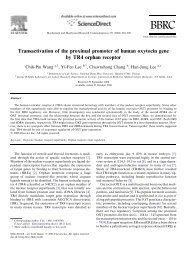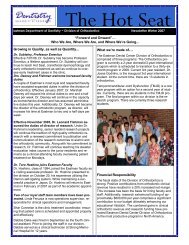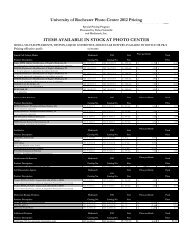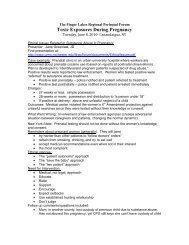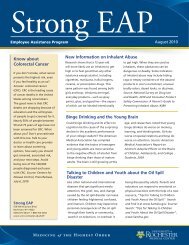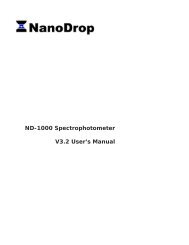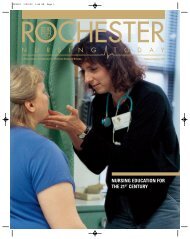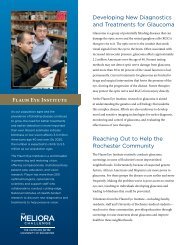SFB Education Challenge - UR_2013 - University of Rochester ...
SFB Education Challenge - UR_2013 - University of Rochester ...
SFB Education Challenge - UR_2013 - University of Rochester ...
You also want an ePaper? Increase the reach of your titles
YUMPU automatically turns print PDFs into web optimized ePapers that Google loves.
Thought Experiment – if you were a cell in a hydrogelSo let’s talk a little more about how hydrogels can be used in biomedical engineering approaches to delivercells and help healing. How many people have heard <strong>of</strong> the special kind <strong>of</strong> cells called Stem Cells?(Wait for students to answer)Does anyone know what makes Stem Cells special?Stem Cells are special because they can grow up to become any type <strong>of</strong> cell in your body! Stem cells canboth replace itself and become many kinds <strong>of</strong> more mature, grown-up cells. When a stem cell replaces itself,it is called “self-renewal”- they are renewing themselves. They can be found in many tissues within the body,including your bone marrow and fat. When stem cells become a more mature type <strong>of</strong> cell, it is calleddifferentiation. Think about this word- differentiation: it starts with different (stem cells are becomingsomething different, a more mature type <strong>of</strong> cell) and ends with ation- which means action. So when cellsdifferentiate, they are becoming a different type <strong>of</strong> cell. This is one <strong>of</strong> the ways your body replaces cells whenthey become old or damaged.When stem cells become neural cells (from the brain or spinal cord), it is called neurogenic differentiation.When they become the cells <strong>of</strong> the bone, it is called osteogenic differentiation. And when they becomemuscle cells, it’s called myogenic differentiation.And cooler, Stem Cells can sense their environment and grow up to become a cell specific to that area <strong>of</strong> thebodySometimes, the body’s own stem cells are not able to fully heal and repair it after damage. Hydrogels can beused to deliver Stem Cells within the body to help with this healing and repair. This is called Regenerativemedicine, which focuses on the use <strong>of</strong> stem cells to repair the body after it becomes damaged, or to replaceor help support part <strong>of</strong> the body if it can’t perform its job well enough. Regenerative medicine is a sub-group<strong>of</strong> tissue engineering, and also involves the use <strong>of</strong> drugs to help repair or replace a biological function, so itisn’t restricted to only the use <strong>of</strong> stem cells.If you were a Stem Cell and we put you in the s<strong>of</strong>test hydrogel what might you grow up to become? Whattypes <strong>of</strong> tissue in the body are really s<strong>of</strong>t?(wait for guesses)Maybe cartilage in your knee, or fat or brain tissue?What if we put you in the hardest hydrogel? What kind <strong>of</strong> tissue might you grow up to become?(wait for guesses)What types <strong>of</strong> tissue in the body are really hard? – maybe bone?(wait for guesses)Finally, what about the medium gel? Muscle?Just by changing the stiffness <strong>of</strong> the hydrogels we can control what kinds <strong>of</strong> tissues Stem Cells can become.Collect gloves and hydrogels and throw them in the garbageSummaryIn summary we have learned that:• Tissues have varying material properties (stiffnesses) based on their function• Matching biomaterial and host tissue properties is a critical design consideration• Hydrogels are highly crosslinked, hydrophilic networksSociety for Biomaterials <strong>Education</strong> <strong>Challenge</strong> 16!


